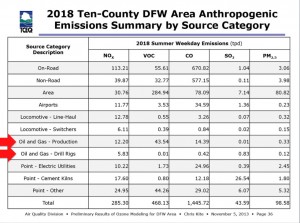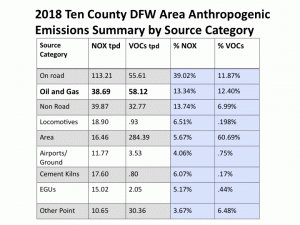Natural Gas
TCEQ: Link Between Fracking and Air Quality, No Cement Controls Just “Because”: Highlights From Tuesday’s Air Meeting
 Dallas Resident Liz Alexander showed up at the Council of Governments meeting room on Tuesday to lend her support to the effort to get more out of an anemic state ant-smog plan than the state wants to give. She was a warm body whose presence would be its own statement of concern. She was being a good trooper by just showing up.
Dallas Resident Liz Alexander showed up at the Council of Governments meeting room on Tuesday to lend her support to the effort to get more out of an anemic state ant-smog plan than the state wants to give. She was a warm body whose presence would be its own statement of concern. She was being a good trooper by just showing up.
At first she sat far from the action amidst the rows of seats for bystanders and, despite encouragement, was resigned to just listening, because as she explained, "she didn't know enough to ask questions."
Then someone urged her to move up to the rectangle of tables where the presenters stand and deliver, where there are microphones to raise the volume of concerns and questions that might be posed by mind-numbing reassurances that everything is going hunky-dory. As more of these air quality meetings have occurred, citizens have been less and less shy about taking up these front row seats that look more official than the rest; look like they should be reserved for guys in suits. Increasingly they're occupied by people in street clothes.
And then, after much information had been paraded in front of Liz, she did something she did not think she was qualified to do only about 90 minutes earlier. She asked a question. It was about what assumptions had been included in the information about unspent air pollution clean-up dollars that are piling up in Austin. She got an answer from a local COG staff person in real time that satisfied her. In the space of one meeting she moved from spectator to participant.
And she wasn't the only one. More than any other meeting so far, this one involved more citizens asking more questions about more subjects – and it revealed just how thin the state's rationale is for doing nothing.
As predicted, it was a day for the Texas Commission on Environmental Quality to explain why its new DFW anti-smog plan was really going to work this time – unlike the five previous failures – and why it wasn't going to be considering any new controls on the Midlothian cement plants or on gas compressors – a refutation of the case Downwinders at Risk had made in its June 16th presentation.
But here's what really happened: For the first time in these proceedings the state admitted that oil and gas emissions have a big influence on regional air quality. And when a former County Judge asked an TCEQ's Air Quality Manager specifically why anti-smog controls already being used on cement kilns in Europe were not being considered for the Midlothian kilns, the staffer couldn't say, offering up only the longest, most pregnant pause by any state staffer in the history of these meetings.
After being heavily criticized for months for leaving at least four monitors above the 75 ppb federal smog standard even after its plan had ended in 2018, the state came back to this meeting saying they only had three sites above 75 ppb now, and by margins that didn't exceed the standard by more than 1 part per billion. Between June and August, there had been a remarkable drop in future estimated smog levels at the area's monitoring sties in the state's computer modeling – particularly at the historically most stubborn monitoring sites in Denton and Northwest Tarrant County.
What had caused this drop? A relatively modest decrease in Nitrogen Oxide pollution of around seven tons a day and a decrease in Volatile Organic Compounds of about 15 tons per day. That's not a lot of pollution to produce such a large decrease in monitor readings in the computer model.
A more important question is: where did the decreases in air pollution come from that could produce such dramatic results in the modeling? The answer: primarily from oil and gas industry sources. Based on TCEQ's own formula relying on the declining number of new wells being drilled in the Barnett Shale.
For the moment forget the methodological qualms you might have about that declining well assumption. Instead, appreciate the fact that the same state agency that couldn't bring itself to ever say the Barnett Shale was producing air pollution holding DFW back from meeting Clean Air Act smog standards now says that it's decreases in that very kind of pollution that are having such a substantial effect on the monitors in the western part of the Metromess that have been the most resistant to other control strategies. TCEQ has just proven a causal link its been denying for over seven years now.
It can't be just a one-way street. If declining oil and gas air pollution equals better air quality in the TCEQ's computer model, so increases in oil and gas pollution must lead to worse air quality.
There are all kinds of reasons to doubt that the drop in total oil and gas air pollution will happen at all or drop as fast or as sharply as the TCEQ predicts. Afterall, they're 0 for 5 in such matters. They may be underestimating the amount of total air pollution from all gas and oil sources and so the drop will not be as sharp. They may be underestimating the impact of lots of new lift compressors that will be showing up to squeeze the last bits of gas from older wells even as new wells are not drilled as often. But as of Tuesday the link has been made by TCEQ itself that such a drop results in big decreases in smog levels in Denton and Northwest Tarrant County. That's something that citizens can use to argue as proof of the impact of oil and gas facilities on local air quality.
Of course, it only took the span of about 30 minutes for the TCEQ to internally contradict itself about those results.
According to TCEQ computer modelers, natural gas Compressor Stations large enough to be considered "point sources" just like cement kilns or power plants will be responsible for over 17 tons of Nitrogen Oxides, and 26 tons of VOCs a day in 2018 – well over the amount of oil and gas pollution decreases that resulted in those lower monitoring numbers in Denton and NW Tarrant County. But according to the TCEQ staff responsible for suggesting new controls in the new smog plan, those numbers are not large enough to have an impact on improving DFW air quality or warranting a policy of electrification for those compressors that could reduce their air pollution to a fraction of those volumes.
So while 7 tons of NOx reduction from Oil and Gas sources is large enough to bring some of the most stubborn monitors down a whole part per billion, reducing air pollution from Oil and Gas sources by another 17 tons of NOx reduction would have no effect on DFW air quality at all and it's just not worth it to make them electrify compressors. Honest, that was the logic in play on Monday, and it didn't hold up very well under questions from people like Liz Alexander.
And that was all before you got to why the Midlothian cement kilns could not, no way, no how, possibly, under any circumstance, be required to install Selective Catalytic Reduction controls, just like their European counterparts have done over the last 15 years.
Turns out, it's just because.
Oh, the TCEQ staffer cited four criteria for any new control measure to meet before it could be considered. Let's see, there was "technological feasibility." Since there are at least seven full-scale SCR units up and running in Europe, that couldn't be a problem. It's accepted technology by some of the same companies operating kilns in the US – including LaFarge-Holcim.
There was "economic feasibility." And since there are all those SCR examples already in the European market and no company has gone bankrupt running them, that's also off the table. Plus the fact that the TCEQ's own 2005 study of SCR concluded it was "available technology" then that would only cost $1000 to $3,000 per ton of NOx removed – versus the up to $15,000 per ton of NOx removed ratio allowed in the state's own official diesel engine replacement program. Coming in at one-fifth the cost of what the state already said was economically feasible, it certainly ruled out that one.
There was the third criterion – that controls couldn't cause ‘‘substantial widespread and long-term adverse impacts.’’ The state said that wasn't the reason they couldn't be considered either, although the TCEQ staffers seemed to hedge a bit here, seemingly wanting to say that, really, they didn't want to cause themselves adverse impact by admitting that they had been wrong for over a decade about this stuff.
The proposed control cannot be ‘‘absurd, unenforceable, or impracticable.’’ Clearly, if the Europeans are doing it on their kilns, it's none of those either. It's quantifiable, and up and running in power plants, cement kilns and incinerators.
And it has to speed the attainment deadline by a year. No problem. SCR could do that if it was installed in a timely fashion.
So at the end of the state's presentation, former Dallas County Judge Margaret Keliher asked the TCEQ staffer exactly why SCR wasn't considered a possible pollution control measure since none of these criteria that had been presented seem to rule it out. And the TCEQ's staffer's response was…………………………………………………………………………………………………………………………………………………………………….
No, really, that was the response. She couldn't say. It was that embarrassing. Because the rejection of SCR by TCEQ isn't based on any of those criteria. It's based on a political decision that's been made that no new pollution controls will be sought on the kilns or any other major industrial polluter as long as Rick Perry is running for President. Or "just because."
How ridiculous is this? At this point the TCEQ is taking an even more regressive view of SCR controls than the cement industry itself. In June, Holcim Cement's Midlothian plant requested a permit from the state that would allow it to build either a Thermal Oxidizer or an SCR until for the control of VOC pollution. Being the free market fanatics the Perry Administration claims to be, doesn't the fact that one of the Midlothian cement plants is asking for a permit that includes the possibility of installing SCR mean it's automatically technologically and economically feasible? The market is never wrong, right? Are the folks at Holcim so enamored of kinky, off-the-wall green technology that they'll just include it in a permit for laughs? These guys are Swiss engineers. They have no sense of humor.
Denial of SCR as a viable control measure that could reduce smog pollution is making the TCEQ contort into sillier and sillier positions. It's making them deny the conclusions of their own almost-decade old report that said it was available to put in a kiln in 2005. It's making them deny the fact that SCR is up and running at over half a dozen kilns in Europe. It's forcing them to once again use the "Midlothian limestone is magically special" defense that has been used to forestall any progress in pollution control there over the last 25 years. The arguments used against SCR are exactly the same as were used against the adoption of less effective SNCR technology before it was mandated. In case you hadn't noticed, they're still making cement in Midlothian despite the burden of having to nominally control their air pollution.
The state wants to power through this anti-smog plan just like they did the last one in 2011. They don't want to have to make industry do anything. But at this point the denial of SCR as a control measure to be included in the next DFW anti-smog plan is so absurd, as is the justification for electrification of gas compressors, that it might be fodder in the next citizens lawsuit over a DFW anti-smog plan, which usually follows these things like mushrooms after a rainstorm.
Want to get involved in this fight and make it more difficult for the state to get away with doing nothing at all about DFW smog – again? Please consider attending our next DFW Clean Air Network meeting – THIS SUNDAY, AUGUST 17th, from 3:30 pm to 5:30 pm at the offices of the Texas Campaign for the Environment across from Lee Park in Dallas, 3303 Lee Pkwy, Suite #402 (214) 599-7840. Citizens are the only force that can make this plan better. Be there, or breathe bad air.
Want to Quiz the State Over Crappy DFW Air? Tomorrow’s Your Chance As the Empire Strikes Back
 Rick Perry's minions at the Texas Commission on Environmental Quality (TCEQ) are drafting a new anti-smog plan for DFW this summer and fall. The only access DFW residents have to how it's being done and why are through periodical regional air quality meetings hosted by the Council of Governments in Arlington. At these meetings staff from TCEQ make presentations on why the air in DFW is getting so much better and why no new pollution control measures are needed to reach smog standards required by the Clean Air Act – despite the fact that the state is 0 for 5 in plans to attain compliance with those standards. In fact, the last such plan from Austin actually resulted in slightly higher levels of smog.
Rick Perry's minions at the Texas Commission on Environmental Quality (TCEQ) are drafting a new anti-smog plan for DFW this summer and fall. The only access DFW residents have to how it's being done and why are through periodical regional air quality meetings hosted by the Council of Governments in Arlington. At these meetings staff from TCEQ make presentations on why the air in DFW is getting so much better and why no new pollution control measures are needed to reach smog standards required by the Clean Air Act – despite the fact that the state is 0 for 5 in plans to attain compliance with those standards. In fact, the last such plan from Austin actually resulted in slightly higher levels of smog.
Tomorrow, Tuesday August 12th there will be another such regional air quality meeting. It's going on from 10 am to 12 noon at the Council of Government headquarters in Arlington at 616 Six Flags Road, right across from the amusement park (insert your own joke here). Of course, it's during business hours – you didn't think they're going to make it easy for the public to attend, did you?
Despite that, beginning in April more and more local residents have been showing up at these meetings to express their concern at the lack of progress in bringing safe and legal air to DFW. One of the reasons is that these meetings are the only forum available to citizens to question TCEQ staff in person – and then ask follow-up questions if you don't like the first answer. It's their only opportunity to be a kind of clean air Perry Mason and because it's a public meeting and everyone's looking at them, TCEQ staff have to at least make an attempt to answer those questions.
Things reached a high point at the last meeting in June when Downwinders and the Sierra Club were allowed to make their own presentations about why the state is falling down on its job. A roomful of concerned citizens and elected officials saw the case against the state was self-evident – all we had to do was quote from its own past press releases and memos to make our point.
Tomorrow's meeting is the first chance the state will have to give a rebuttal to those citizen group presentations. Staff will present all the reasons why we don't need new air pollution controls on the Midlothian cement plants, the gas industry, or the East Texas coal plants, and why another do-nothing anti-smog plan from Austin will be just dandy.
And so, if between inhaler bursts you ever wanted to quiz officials about Rick Perry's air pollution strategies, tomorrow's meeting is going to be your chance.
You may think you're not qualified, but you'd be wrong. Simple common sense questions are often the hardest ones for the TCEQ staff to answer, because you know, they're based on common sense, and so many of their policies aren't.
This is how citizens uncovered the fact that TCEQ was hiding oil and gas pollution in other categories not named oil and gas. This is how we got the TCEQ to release maps of where all the gas industry compressors in DFW are after first explaining there were no such maps. And so on.
All that you need is a curious mind. They're not prepared for those.
Tomorrow, 10 to 12 noon is your opportunity to show your concern about breathing bad air, your desire to see major industrial sources of pollution better controlled, and why you want these anti-smog plans to do more. Be there or keep breathing bad air.
Three Easy Pictures: Why the TCEQ Didn’t Want Compressor Locations Publicized
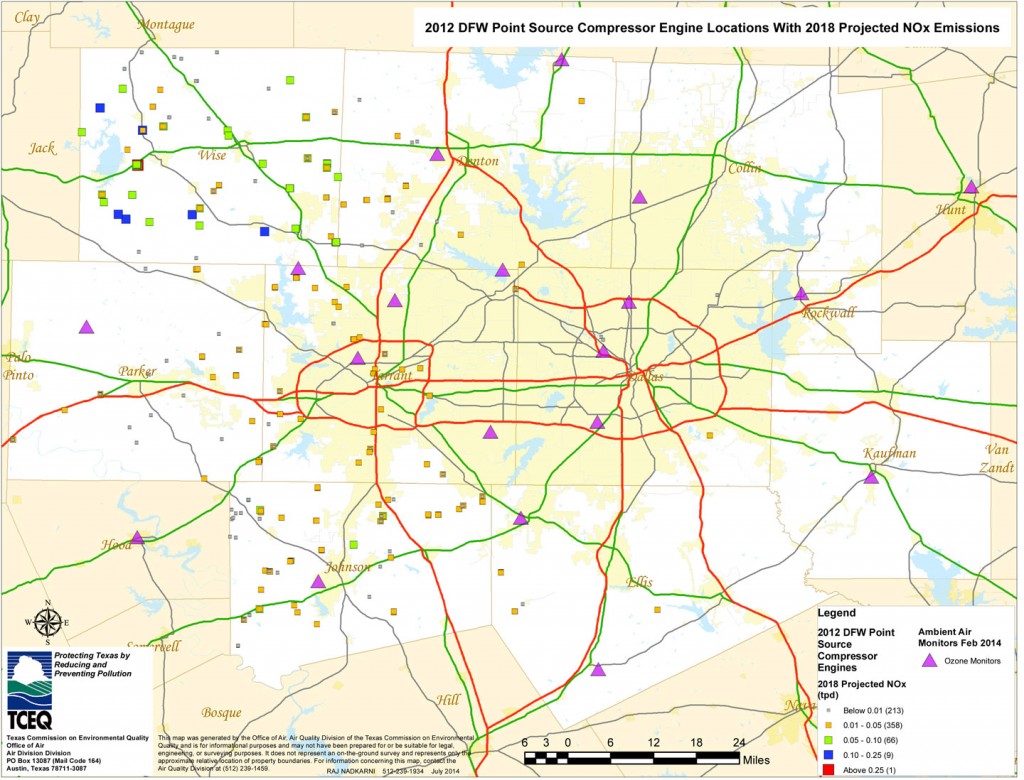
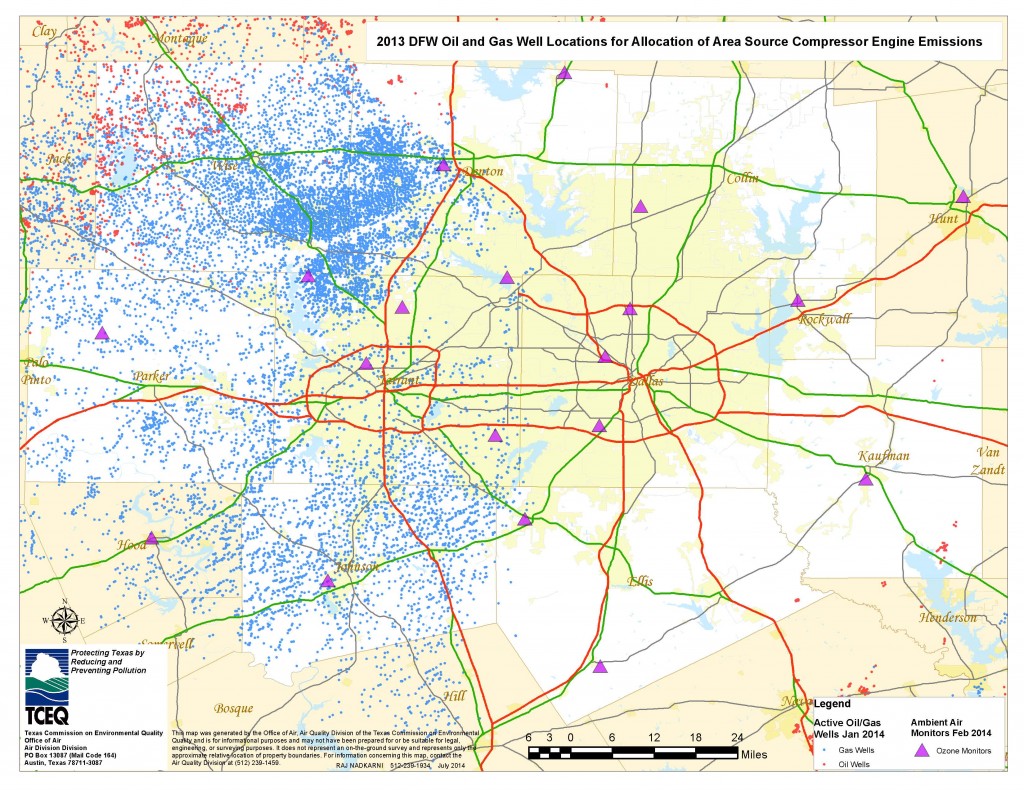
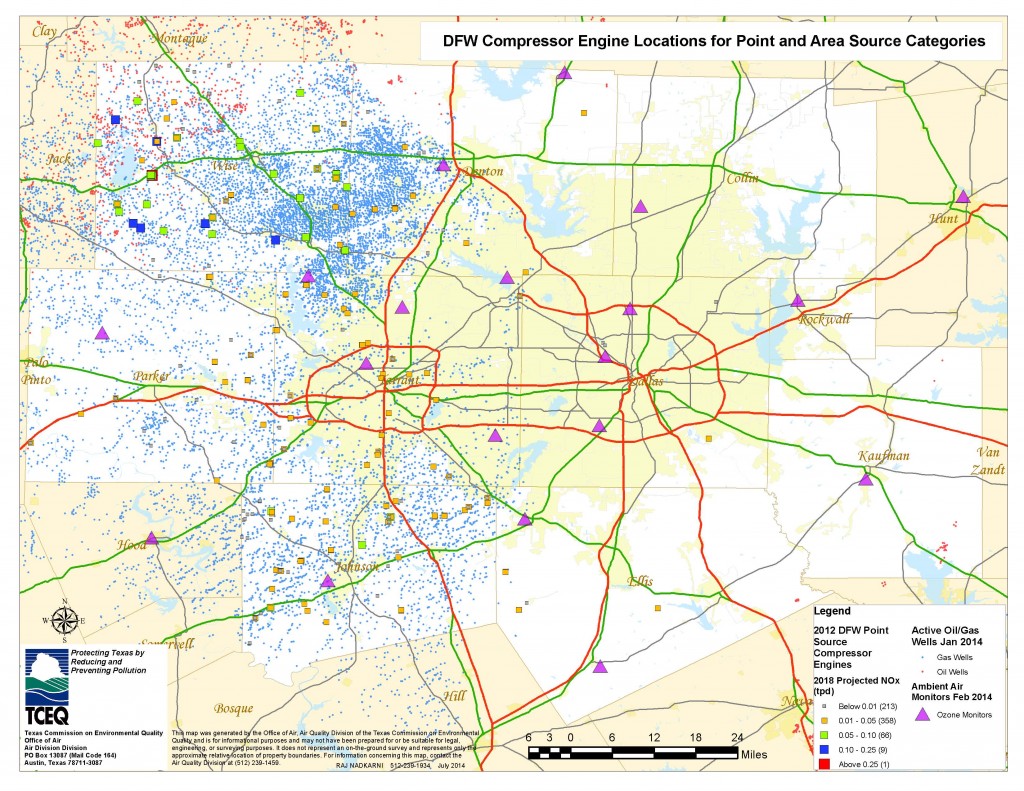 These are maps that supposedly weren't available…until they were.
These are maps that supposedly weren't available…until they were.
From January all the way through June, citizens involved in watch-dogging the state's drafting of an anti-smog plan for North Texas had been asking if the Texas Commission on Environmental Quality had maps of the locations of all the gas compressors in the 10-county DFW "non-attainment" area for ozone.
The answer from the state, over the course of at least three regional air quality meetings in Arlington, was always no.
Then State Representative Lon Burnam asked the same question, officially, in a letter to TCEQ. About two weeks ago, he got these three maps in the mail. Thanks to Representative Burnam for his follow-though.
This dodge followed an attempt by the state to hide the emissions from these compressors in other categories besides "Oil and Gas" in an attempt to minimize the industry's air pollution impacts on DFW air quality.
You can understand why TCEQ wasn't eager to show these maps.
The first shows the location of 647 large gas compressors. The volume of air pollution from each of these compressors is so large that they're considered "point sources" like power plants, cement plants, manufacturing plants, etc. According to the TCEQ, these larger compressors will be emitting over 14 tons of smog-forming Nitrogen Oxide pollution PER DAY by 2018.
The second shows the approximate location of the thousands of smaller, "area sources" compressors. TCEQ doesn't really know how many of these there actually are – they've never counted and no inventory by industry is required.
Instead, the state bases the number and approximate location of these smaller compressors on the production rates of gas in the Barnett Shale, as reported by the Railroad Commission, and disperses them accordingly.
There's some question about whether this is the most accurate way to take a count – a lot of industry literature says you should use the number of wells and the age of the wells instead of the production rate because as a gas field gets older, operators use more compressors to extract harder-to-get gas.
This is important because while production rates in the Barnett Shale have gone down, the number of wells is increasing.
The upshot is that as impressive as all those dots seem in the second map, they may actually represent an underestimate of the number of smaller compressors on the ground. As it is, TCEQ estimates these compressors will collectively release another six and a half tons of smog-forming Nitrogen Oxides PER DAY by 2018. That's in addition to the pollution of the larger point source compressors.
The last map is a combination of the first two. In all three the region's smog monitors are the purple triangles. Please take note of their location as well.
For over a decade now it's the monitors at the Denton Airport and in Northwest Tarrant County – at Meacham Field, in Keller, in Grapevine and Eagle Mountain Lake – that have recorded the highest smog readings in the entire regions.
There's no question as pollution accumulates over Dallas and Fort Worth and blows Northwest, ozone levels get higher. It's also true the pollution plumes from the Midlothian cement plants can blow directly into the paths of many of these monitors. But can anyone look at these maps and not realize that these gas compressors are also contributing to the high readings being recorded at the monitors in Denton and Northwest Tarrant County?
That's the real reason TCEQ didn't want the public to see these maps.
There's another regional air quality meeting next Tuesday, August 12th in Arlington from 10 am to 12 noon at the North Central Texas Council of Government offices at 616 Six Flags Road. These meetings are the only chance that citizens have to ask questions of TCEQ staff about the information going into drafting the new anti-smog plan. Without those kinds of questions, we still wouldn't know how much air pollution these gas compressors are emitting, or their location. Rep. Burnam would not know what official requests to submit. Information is power. Come get a little more empowered this next Tuesday.
Power of the Press: Week after Trib Report on DFW Smog, First “Exceedences” of 1997 Standard
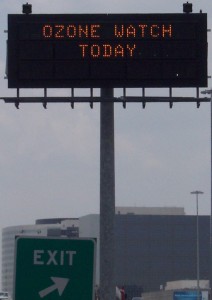 It was only eight days ago the that online Texas Tribune did the first real overview of DFW air quality for this "ozone season." Borrowing heavily from the June 16th Downwinders at Risk presentation to the North Texas regional air quality committee, it concluded that there had been no discernible progress in regional air quality for the past five to six years despite a new state anti-smog plan aimed at getting the area below the 1997 standard of 85 parts per billion.
It was only eight days ago the that online Texas Tribune did the first real overview of DFW air quality for this "ozone season." Borrowing heavily from the June 16th Downwinders at Risk presentation to the North Texas regional air quality committee, it concluded that there had been no discernible progress in regional air quality for the past five to six years despite a new state anti-smog plan aimed at getting the area below the 1997 standard of 85 parts per billion.
Ironically, up to that point, DFW had been enjoying one of the wettest, coolest, most ozone alert-free summers on record. Not one 100 degree day until July and only one "bad air" days of note on June 11th. It looked like we might actually be able to meet the 1997 standard of 85 ppb for the very first time.
That's all changed with this past weeks' return to familiar form. In just seven days, they've been at least four official "ozone alerts" issued for DFW by the Texas Commission on Environmental Quality. Those had produced four "exceedences" of the current 75 parts ppb standard, which the state is now aiming at with another "do nothing" plan under development and due out by the end of the year. On Wednesday the trend got more serious with the addition of the first two "exceedences" of the older 1997 standard we can't seem to conquer – a reading of 88 ppb at the NW Fort Worth monitor at Meacham Field and a 91 at the usually quiet Granbury monitor in Hood County. In the latter case, one mid-afternoon hourly reading reached as high as 113 – just 12ppb short of a violation of an even more ancient standard left over from the 1980's.
For comparison's sake, EPA scientists just sent a letter to EPA Administrator Gina McCarthy recommending that a new, lower federal standard for ozone be set at 60-70 ppb.
It will still take another week of 85 ppb plus days to produce the "fourth highest" readings at the Denton or Keller sites to combine with their 2013 averages and keep DFW in violation of a 17-year old ozone standard. But then again, we have all of August and September to go.
Not surprisingly, two of this summer's hot spots include traditionally troublesome monitors – the Denton and NW Fort Worth site. Tarrant and Denton Counties have historically been the places where the region's highest readings have originated. One reason is wind direction – smog accumulates from upwind sources like the Midlothian cement plants and blows Northwest during the summer. Another more recent reason is the mining of Barnett Shale gas deposits that release huge quantities of smog-forming pollution in the western half of the Metromess, a phenomenon that's been examined in a new UNT study that divided the region's ozone monitors into "Fracking" and "Non-Fracking" areas and found significantly higher readings among those in the Fracking area.
As we went to press with this post, Thursday's readings looked to be producing another round of 75 ppb or higher results. Adding to this year's ozone season irony is that over the last 20 years, July has traditionally been the summer month that produced the fewest number of high ozone readings, book-ended by higher numbers in June and August-September.
Depending on the weather, DFW may still be able to make it over the 1997 standard, 85 ppb hump. But based on this past week's results, that hump just got bigger. Stay tuned.
New Encyclopedia of Fracking Harms
 Those that keep up with these things know the rate of new information about fracking has increased almost exponentially for the past couple of years. New studies arrive monthly covering a host of subjects – air pollution, water contamination, earthquakes from injection wells, truck traffic, etc. So many it's hard to keep up and get a view above the fray. Now, at least for the next couple of months, there's a new comprehensive guide for journalists, citizens, and policymakers that tries to put all the latest evidence into one publication.
Those that keep up with these things know the rate of new information about fracking has increased almost exponentially for the past couple of years. New studies arrive monthly covering a host of subjects – air pollution, water contamination, earthquakes from injection wells, truck traffic, etc. So many it's hard to keep up and get a view above the fray. Now, at least for the next couple of months, there's a new comprehensive guide for journalists, citizens, and policymakers that tries to put all the latest evidence into one publication.
Produced by the Concerned Health Professionals of New York, the new document has the slightly unwieldy title of "Compendium of Scientific, Medical, and Media Findings Demonstrating Risks and Harms of Fracking." Clocking in at over 60 pages, it does manage to cover a lot of ground, including air and water pollution, occupational hazards, noise pollution, earthquakes, flooding, radioactive releases, climate change, agricultural threats, crime rates, property values, and the inflated economics of gas reserves. In short, for now, it appears to be the one-stop shop for everything you wish you didn't need to know about fracking, but wanted to ask.
Extensively researched and footnoted, the Compendium is something you can hand your city council member or State Representative in hopes that their superficial scanning at least produces a better appreciation for the myriad of hazards now associated with the practice.
Mansfield Gas Well Awareness Group Opens Up New Front in DFW Urban Drilling Fight
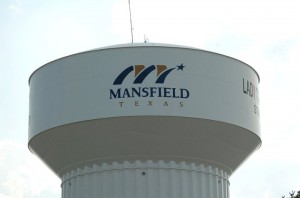 Ever since winning the Dallas Gas Wars in December of last year, Downwinders at Risk and our partners at the Texas Campaign for the Environment have been looking for a place and time to take the responsible drilling fight deeper into the Barnett Shale. We're glad to announce that we're teaming up with the newly formed Mansfield Gas Well Awareness group to do just that.
Ever since winning the Dallas Gas Wars in December of last year, Downwinders at Risk and our partners at the Texas Campaign for the Environment have been looking for a place and time to take the responsible drilling fight deeper into the Barnett Shale. We're glad to announce that we're teaming up with the newly formed Mansfield Gas Well Awareness group to do just that.
Mansfield is a relatively small Tarrant County town with a big gas industry presence. Sandwiched between Arlington and Fort Worth, it has a population of 59,000 spread over 36 square miles. it already has 200 wells on 51 gas pads with a total of 512 planned – or an average of 14 per square mile. Many of the most problematic wells are operated by Eagle Ridge – the same company whose antics single-handedly began the current "ban fracking" campaign in Denton. Like Denton, Eagle Ridge's Mansfield wells are close to homes, and have been known to spew surrounding neighborhoods with their own scrubbing bubbles concoction from flowback operations and incurred a rare violation notice from the state in February. The city also hosts a notorious Teas Energy Midstream compressor station that's a suspect in showering homes with an oily film from what was most likely from a messy blown down accident in May.
Those incidents got people's attention. Seeing themselves as the victims of a permissive "Fort Worth Model" of gas regulation, local residents are now moving to organize around a citizen-friendly "Dallas Model" with more protective setbacks, restrictions, and monitoring. As their new website and Facebook page notes, "Mansfield Gas Well Awareness is not a movement against natural gas or exploration of natural resources. Rather, we are against the permitting of toxic gas well activities near homes, schools, day cares, and parks. We are a movement of concerned residents that live in Mansfield who are for clean air, safe and healthy communities, and protecting peoples' rights to peacefully enjoy their property."
As is so often the case, pollution problems on the ground are connected to ethical problems at City Hall. Mansfield councilman Stephan Lindsey, who until recently was Mayor Pro-Tem is Senior Director of Government and Community Affairs for Quicksilver Resources, "a Fort Worth natural gas and oil exploration company" who never feels compelled to recuse himself from any votes concerning the municipality's regulation of the gas industry. Councilman and New Mayor Pro-Tem Larry Broseh is owner and President of Cam Tech, a company "dedicated to providing the drilling industry qulity pipe handling equipment," and also doesn't mind using his public office to vote on behalf of his industry interests. That means almost a third of the seven member Mansfield city council has professional gas industry ties.
As it happens, Mr. Lindsey is up for re-election next May. Old timers might recall that the Dallas drilling fight got real traction when gas friendly incumbent city council member Dave Neumann was upset by newcomer Scott Griggs way back in 2011. Although the new group hasn't officially targeted Lindsey, defeating him with a candidate more skeptical of industry claims would certainly send a strong message that Mansfield residents don't want the fox guarding their chicken coops.
The good news is that Mansfield Mayor David Cook took MGA members up on their invitation to see the Downwinders' presentation to the regional air quality meeting in Arlington on June 16th, where Director Jim Schermbeck devoted half of his time to explaining why gas compressors should be electrified. As far as we know, Cook was the only DFW are Mayor in attendance and it was a real coup for the young group to get him there.
MGWA's website already has some amazing pics and videos, as well as depressing factoids to share. If you know someone living in Mansfield, please let them know a new voice for citizens concern in on the scene and organizing to clean up the current messes as well as prevent new ones. Now that Downwinders has joined the fight, we'll certainly keep you posted on developments as well. Westward ho!
Highlights from Monday: How the State Hides Gas Industry Pollution
 Want to see one example of how low state bureaucrats will stoop to underplay the significance of the impact of oil and gas pollution on DFW air quality? Take a look at some slides that were part of Monday's presentation by Downwinders at Risk's Jim Schermbeck to the regional air planning meeting.
Want to see one example of how low state bureaucrats will stoop to underplay the significance of the impact of oil and gas pollution on DFW air quality? Take a look at some slides that were part of Monday's presentation by Downwinders at Risk's Jim Schermbeck to the regional air planning meeting.
In the first you'll see how the state officially ranks all the "source categories" for human-made, or "Antrhopogenic," smog-forming Nitrogen Oxides (NOx) and Volatile Organic Compounds (VOCs) pollution in North Texas (all the numbers are Tons Per Day):
Yes the pic is fuzzy, (we can land a person on the Moon but can't seem to get charts to show up with a jpeg format online) but if you squint really hard, you'll notice there are two categories for Oil and Gas pollution numbers among the more traditional "Point Sources," Off-Road, "On-Road", etc – "Oil and Gas Production" and "Oil and Gas – Drill Rigs." Looking at these two categories you might think that adding them together would produce total Oil and Gas pollution numbers. You'd be wrong.
As it turns out, there are other Oil and Gas pollution numbers hidden away in other categories in this chart not labeled "Oil and Gas." For example, in both the "Area" and "Point-Other" categories are the numbers for NOx and VOCs pollution from gas compressors. But wait, you object, aren't gas compressors an integral part of any kind of "Oil and Gas Production?" Yes, yes they are. So why aren't they included in that category instead of being stuffed anonymously in these other categories? Great question. Perhaps it has something to do with the volume of pollution they release. Because when you finally wrestle the numbers from the Texas Commission on Environmental Quality (the TCEQ didn't voluntarily offer this information), compressor pollution turns out to double the amount of smog-forming NOx released from the Oil and Gas industry in the DFW 10-county "non-attainment area." And NOx pollution is what the TCEQ keeps saying is driving our chronic smog problem. Here's the way Schermbeck presented the same TCEQ "source categories" with the compressor numbers now teased out and added to the ones already identified as Oil and Gas: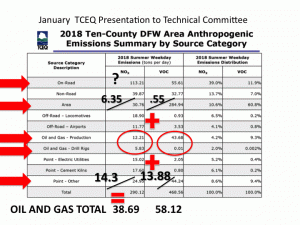
These additions raise the industry's polluter profile significantly. And that's what this next slide is doing. It's totaling all the Oil and Gas pollution and then re-ranking the categories based on these new numbers. Same totals, just different, and more honest, organization of the individual source figures. Instead of Oil and Gas emissions looking relatively small in relation to other sources like cement kilns and power plants and even locomotives, it escalates the Oil and Gas industry into one of the region's foremost industrial air polluters:
And even this much larger number is still underplaying the total amount of air pollution fracking adds to regional air quality because the state hasn't bothered to try to tease-out the "on-road" pollution that all those fracking waste and water trucks adds to the mix. State air modelers shrugged their shoulders and said they couldn't figure out how on earth to do that. Just by "Googling" the subject, Schermbeck found at least two previous studies that did that very thing – a 2005 Denton report and a 2013 Rand Corporation report that even estimated the amount of dust pollution raised by those trucks.
While those truck totals remain a mystery for now, using the TCEQ's own numbers, compressors make up at least 53% of the total NOx pollution released by the Oil and Gas industry in North Texas, and a full quarter of all VOC pollution released. According to Schermbeck, that's why they make such good targets for electrification, an air pollution control measure he was recommending as part of his larger presentation to the regional air planning committee on Monday.
This is just one example of the kind of duplicitous behavior the state of Texas is resorting to in trying to hide the true environmental and public health impact of the Oil and Gas industry. No slight of hand is too petty. Only by diligent digging by citizens is the truth coming out, ton by ton.
Schembeck's entire (unfuzzy) presentation is now online at the North Central Texas Council of Governments website as part of the June 16th agenda. It loses something without his accompanying narration but the jest of it is easily discerned for those who want to plod through it: TCEQ is doing anything but a sincere job of building a serious clean air plan for DFW. But then again, we bet you already knew that.
Rick Perry, with a Smoking Gun, in the COG Headquarters: Monday at 10 am
 The latest chapter in a decades old mystery game of "Get a Clue" happens tomorrow morning, Monday, June 16th when representatives of the Sierra Club and Downwinders at Risk present their case against the current state anti-smog plan during the regional air planning meeting at the headquarters of the North Texas Council of Governments, 616 Six Flags Road in Arlington. Come find out who and/or what keeps the DFW area from ever meeting federal clean air standards year after year and what can be done about it. The meeting starts at 10 am. Citizen groups are expected to do their presentations in the 11 to 12 hour. Then we'll all have a debriefing lunch at the Subway's down the street hosted by State Representative Lon Burnam. Y'all come.
The latest chapter in a decades old mystery game of "Get a Clue" happens tomorrow morning, Monday, June 16th when representatives of the Sierra Club and Downwinders at Risk present their case against the current state anti-smog plan during the regional air planning meeting at the headquarters of the North Texas Council of Governments, 616 Six Flags Road in Arlington. Come find out who and/or what keeps the DFW area from ever meeting federal clean air standards year after year and what can be done about it. The meeting starts at 10 am. Citizen groups are expected to do their presentations in the 11 to 12 hour. Then we'll all have a debriefing lunch at the Subway's down the street hosted by State Representative Lon Burnam. Y'all come.
Human-Induced Earthquakes and Cooking the Planet: We’re Living the Next Hollywood Sci-Fi Blockbuster
 "Environmentalism" as a cause in America has its roots in the wilderness, the "otherness" a person can discover when he or she is separated from their own kind and put among crowds of the planet's non-human inhabitants. Walden Pond. National Parks. These were all meant to be meditative retreats from "civilization," from which you could escape. Environmentalism was a revelatory and individualistic experience.
"Environmentalism" as a cause in America has its roots in the wilderness, the "otherness" a person can discover when he or she is separated from their own kind and put among crowds of the planet's non-human inhabitants. Walden Pond. National Parks. These were all meant to be meditative retreats from "civilization," from which you could escape. Environmentalism was a revelatory and individualistic experience.
Then came the understanding of environmentalism as a way to affect collective public health. Air pollution we breathe into our bodies causes lung cancer and asthma. Swallowing water with toxins in it when you're pregnant can cause birth defects. Eating foods with pesticides in them can affect a child's hormones. Still, the impacts were mostly seen person by person, and they depended on lots of variables – genetics, location, exposure. Not in my backyard.
Now however we're in a whole new age of cause and effect. The scale is planetary. The sky we live under as well as the ground we walk on.
Imagine Hollywood makes a movie about alien invaders who want to reshape the Earth for their own purpose, say like "Battleship." They begin pumping in massive quantities of CO2 and methane, driving up the temperature way beyond anything in recent history and setting-off all kinds of chain reactions among species and weather conditions. They begin extracting minerals by poking deep holes in the earth and then setting off large explosions, the waste of which causes not-insignificant earthquake activity when they pump it back into the ground under tremendous pressure. Their huge spaceships sometimes leak radioactivity, and if they just happen to be sitting beside oceans that can be used as industrial-size septic tanks, all the better.
That's what it feels like now, in 2014.
In case you missed it, the United States Geologic Service issued its very first "Earthquake warning" for Oklahoma:
"A new study found that earthquakes in Oklahoma rose by 50 per cent over the last seven months, leading researchers to warn that the risk of a damaging earthquake measuring a magnitude of more than 5.5 has increased significantly in the state. Agencies reported 183 earthquakes of magnitude 3.0 or higher from October until April 14th, compared with an average of only two per year from 1978 to 2008."
Usually reserved for places like California or Alaska to warn residents of the risk of damaging aftershocks, this is the first time the USGS has issued an earthquake warning for a state east of the Rockies. In the Sooner State, the aftershocks are thought to be caused by fracking waste injection wells. A Cornell University study released this week showed a link between waste wells and earthquakes up to 50 kilometers away.
"A new study of the Jones earthquake swarm, occurring near Oklahoma City since 2008, demonstrates that a small cluster of high-volume injection wells triggered earthquakes tens of kilometers away. Both increasing pore pressure and the number of earthquakes were observed migrating away from the injection wells.
"The existing criteria for an induced earthquake do not allow earthquakes associated with the well activity to occur this far away from the wellbore," said Katie Keranen, assistant professor of geophysics at Cornell University, who led the study of the Jones earthquake swarm. "Our results, using seismology and hydrogeology, show a strong link between a small number of wells and earthquakes migrating up to 50 kilometers away" said Keranen. "
Moreover, we're just beginning to understand the threat to infrastructure from human-induced earthquakes…
"Last week scientists attending the Seismological Society of America annual meeting in Anchorage, Alaska called for more research into the relationship between fracking wastewater disposal and earthquake activity.
Gail Atkinson, an earth sciences professor at the University of Western Ontario, presented research at the conference highlighting the “significant and as-yet-unquantified risk” to the integrity of critical infrastructure, such as major dams and nuclear power plants posed by induced seismicity.
Part of the problem is that fault lines in the areas most affected by fracking operations are often poorly and incompletely mapped. Texas, Ohio, Colorado and Oklahoma, which have in recent years experienced unprecedented seismic activity, have never been made a priority like California and other states where quakes have long been a threat."
SMU and USGS scientists looking into the Azle earthquake swarm were also at this same Alaska conference presenting their paper showing the vast majority of recent earthquakes near that city were centered between two injection wells, including a large XTO one. Expect to see some follow-up as reporters and citizens take their first look. And while we really do expect an alien invasion to occur before the State of Texas voluntarily does anything to stop the problem in Azle, there's a House Energy Committee, Seismic Activity Sub-Committee hearing next Monday May 12th, where only invited testimony will be heard. Sharon has the details for folks that want to make another trip to Austin.
Meanwhile, April saw new highs in atmospheric poisoning.…
The end of April has arrived, and with it, the record for the first month in human history with an average carbon dioxide level in Earth’s atmosphere above 400 parts per million has been set.
With a little more than 24 hours left in the month, the average for April can't slip below 400 ppm. “Every day in April has been over 400 ppm,” said Pieter Tans, a climate scientist with the National Oceanic and Atmospheric Administration.
The levels of carbon dioxide in the atmosphere are monitored from a site atop Hawaii’s Mauna Loa volcano, where they have been measured continuously since 1958. The long record has charted the steep rise of the greenhouse gas — the most prevalent in Earth’s atmosphere — as a result of human emissions.
The first measurement in excess of 400 ppm was made on May 9, 2013. This year, the level rose above that mark a full two months earlier, and has remained above 400 ppm steadily since the beginning of April.
And lest you think you'll be long gone before the effects of this change affect you and yours, yesterday's new National Climate Assessment report wants you to know that,
"The effects of human-induced climate change are being felt in every corner of the United States, scientists reported Tuesday, with water growing scarcer in dry regions, torrential rains increasing in wet regions, heat waves becoming more common and more severe, wildfires growing worse, and forests dying under assault from heat-loving insects.
Such sweeping changes have been caused by an average warming of less than 2 degrees Fahrenheit over most land areas of the country in the past century, the scientists found. If greenhouse gases like carbon dioxide and methane continue to escalate at a rapid pace, they said, the warming could conceivably exceed 10 degrees by the end of this century.
“Climate change, once considered an issue for a distant future, has moved firmly into the present,” the scientists declared in a major new report assessing the situation in the United States."
Conscience-ridden scientists making dire warnings about the threat. A government too slow or self-interested to act to thwart the threat. We know this movie. From the POV of the moving camera, we see the same forces of darkness making things go boom underneath us are also filling up our thin layer of atmosphere with gunk. This is no longer something we can escape from, nor is it a matter of local public health. After years of hearing that the sky is falling, now it really is. Only instead of aliens causing it, it's us treating the planet as if we were.
In such a Hollywood Blockbuster, the heroes would be the scrappy, common-sense fueled citizenry who had managed to outrun and outsmart the aliens in various small and large ways while governments fumbled and greedy privateers made deals with the newcomers. With some imagination, a rag tag group of locals fighting a single alien ship out in the boondocks would finally find an out-of-the-box way to disrupt, confuse, and eventually defeat the enemy. As the credits begin to roll, you can see word of this grassroots strategy spread across the globe and its effectiveness showing up in Paris, Moscow, Nairobi, Mexico City, and Hong Kong.
This is that movie. We're in it. Are you a member of the scrappy resistance or an anonymous uncredited crowd extra? Quick, the tide's coming in.….
Thank You. Citizens Might Have Just Saved The Local Air Planning Process…From Itself
 A year from now, last Thursday' meeting in Arlington may be seen as a turning point.
A year from now, last Thursday' meeting in Arlington may be seen as a turning point.
Local residents refused to let the air quality planning process die, showing up in numbers that forced officials to switch to a larger room, and making sure their opposition to another state "do-nothing" air plan was heard loud and clear.
Their participation had already changed the day's agenda. Included was a breakthrough UNT study that directly challenges the Texas Commission on Environmental Quality's claim that natural gas emissions don't increase DFW smog.
UNT's Dr. Kuruvilla John's presentation of the new study received quite a bit of media coverage, before, during, and after Thursday's meeting. You can find some of the best coverage by clicking on the links below.
UT-Austin Study Reveals "Underestimates"
Dr. John's presentation influenced another researcher's slide show as well. Scheduled to speak about older, more generic ambient air measurements for ozone, Dr. David Allen of UT Austin instead presented more recent research into gas pollution as well.
Overlooked in the debut of the UNT study, Allen's constant monitoring of one drill site in Fort Worth revealed that the TCEQ was underestimating emissions from the pneumatic valves at the site by 159%.
That was news to both citizens and TCEQ, who said they hadn't looked at Allen's research and hadn't corrected their inventories to account for such underestimates. Valves like these are powered by natural gas, are quite numerous on gas equipment, and account for a large percentage of VOCs released from a fracking site.
A Better Picture of Oil and Gas Pollution
Citizen cross-examination of TCEQ staff members present at the meeting also revealed a different look at the volume of Oil and Gas industry pollution in the 10-county DFW "non-attainment area"
Up to Thursday, TCEQ was dispersing Oil and Gas pollution across several categories, making it impossible to show the true total impacts.
Here's an example of the way TCEQ likes to present the info:
SOURCES OF SMOG-FORMING NITROGEN OXIDE POLLUTION (NOx)
IN DFW's NON-ATTAINMENT AREA
1. "On Road" vehicles 113.21 tons per day
2. "Non-Road" vehicles" 39.87 tpd
3. "Area" 30.76 tpd
4. "Other Point Sources" 24.95 tpd
5. "Locomotives" 18.90 tpd
6. "Cement Kilns" 17.60 tpd
7. "Electric Utilities" 15.02 tpd
8. Oil and Gas Production 12.21 tpd
9."Airports" 11.77 tpd
10. Oil and Gas Drill Rigs 5.83 tpd
TOTAL 290.12 tpd
This makes it look like Oil and Gas pollution is not that big a deal.
But it turns out TCEQ is hiding 28.44 tpd of NOx gas compressor pollution in the "Area" and "Other Point Source" categories.
This was brought out in questioning on Thursday. Once you add these figures to the other Oil and Gas emission numbers spread out over different categories, this is what you get:
SOURCES OF SMOG-FORMING NITROGEN OXIDE POLLUTION (NOx)
IN DFW's NON-ATTAINMENT AREA
1. "On Road" vehicles 113.21 tpd
2. Oil and Gas Industry 46.48 tpd
3. "Non-Road" vehicles 39.87 tpd
4. "Locomotives" 18.90 tpd
5. "Cement Kilns" 17.60 tpd
6. "Area" 15.93 tpd
7. "Electric Utilities" 15.02 tpd
8. "Other Point Sources" 11.34 tpd
9. "Airports" 11.77 tpd
TOTAL 290.12
(Earlier today we put out an e-mail alert that left 10 tons off the "Area" category in this second chart, greatly affecting its ranking. That mistake is corrected in this version of the chart and we apologize for any confusion that might have caused)
When you quit playing the state's shell game with Shale pollution, the Oil and Gas industry becomes the region's second largest source of NOx pollution – the kind of pollution TCEQ says is the main driver of smog in DFW (not even counting all the pollution from O&G fracking trucks still hiding in the "On Road" category).
There have been control measures for cars to reduce NOx. There have been controls on heavy duty equipment and trucks to reduce NOx. There have been new controls on locomotives to reduce NOx pollution. There have been controls on airport ground equipment to reduce NOx pollution. There's even been middling controls to reduce the NOx from the Midlothian cement kilns. But where's the controls to reduce NOx from the Oil and Gas industry – the one source in this list that hasn't had the same kind of regulatory attention? Good question – save it for next time.
Citizen Participation is Crucial
This is the kind of close examination the TCEQ hopes to avoid by limiting debate on this new clean air plan, scheduled to be submitted to EPA by July next year. And it's exactly why citizens need to keep showing up.
Because of the momentum and interest coming out of Thursday's meeting, citizens also got the next scheduled pow-wow of the local air planning process moved up to late May or early June instead of waiting until July.
We're already taking suggestions for what you want to see on that agenda, so don't be shy. And thank you again for restoring some tiny amounts of integrity into a process that's been swamped by Rick Perry's indifference.
You're making a difference, and that's all anybody can do. This last Thursday it was a big difference. Let's try to do the same in May.
Some Coverage of Thursday's Air Planning Mtg.
Channel 8: "UNT researchers say fracking a contributor to North Texas smog problem"
Texas Observer: "Studies: Links Between Fracking and Smog Pollution Stronger Than State Claims"
Star-Telegram: "Natural Gas Production Contributing to Higher Ozone Levels, study Finds"
Denton Record Chronicle: "Officials: No New Plans to Clean Up Air"
HOW YOU CAN SAY "THANK YOU" BACK
Here's what Downwinders at Risk did this past week to make sure Thursday's air quality meeting wasa success:
1) Pressed for and got the UNT study linking fracking to smog on the meeting agenda after being told it would not be included.
2) Sent out releases to the media advertising the UNT presentation.
3) Sent out alerts to you and others to let you know about the new UNT study and the meeting itself.
4) Sent out a "Citizens' Guide to the Meeting" so you could be prepared for Thursday.
5) Showed-up at Thursday's meeting with handouts showing the lack of air quality progress in DFW and the lack of a complete plan by TCEQ
6) Used our questions to reveal how TCEQ was hiding Oil and Gas industry pollution totals in their data
7) Pressed for and got an earlier "next meeting" of the local air quality planning group
8) Sent out this follow-up so that everyone knows what went on and what the news is from the meeting
A local forum for clean air issues was about to disappear.
Only the last month's mobilization of citizens prevented that from happening on Thursday.
Who began that mobilization?
We did.
We really need your financial help to keep doing this. We don't get state or national funding – just local money from people like yourself.
Thanks. We very much appreciate it.

